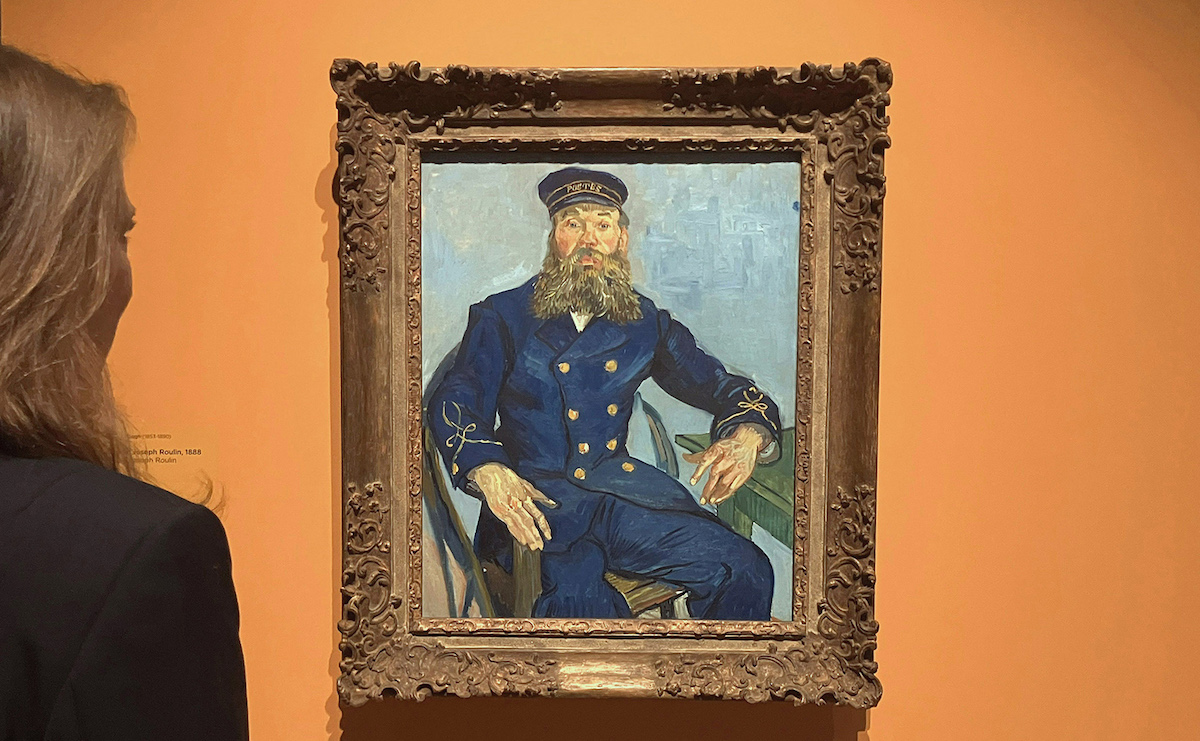‘Now I’m working with another model, a postman in a blue uniform with gold trimmings, a big, bearded face, very Socratic—a raging republican, like père Tanguy. A more interesting man than many people, wrote Vincent to his brother Theo in late July 1888, from Arles, underlining the word ‘postman’.
Throughout his career as an artist, Van Gogh always drew or painted working-class people. From the Dutch peasants in Brabant to the elderly of the hospice in The Hague, to the Parisian colour merchant Julien Tanguy, his favourite models were ordinary folk. This was a radical choice from the outset – in 1880, he observed ‘the miners and the weavers’, which were ‘yet unpublished or almost unpublished’ types. Once Vincent arrived in Provence, the postman of Arles, Joseph Roulin, was no exception to this pattern.
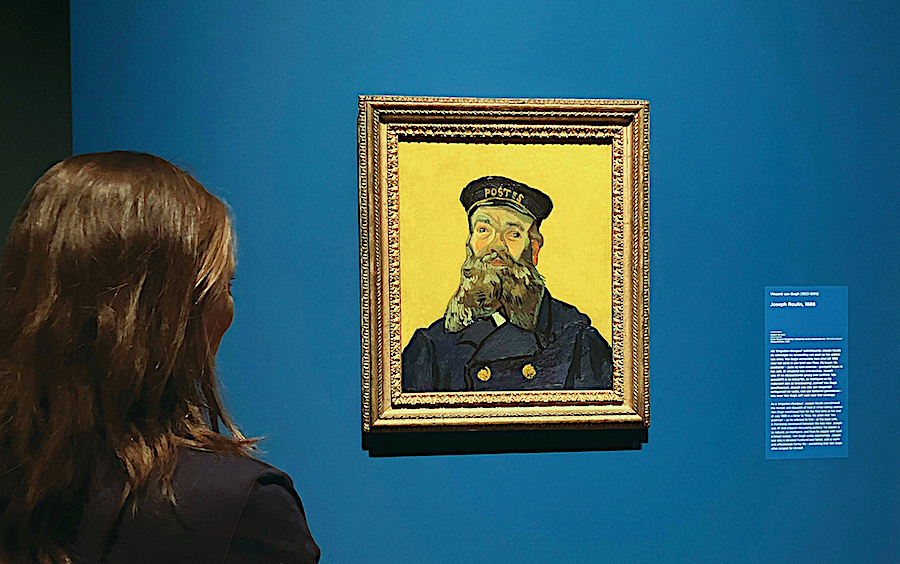
Vincent van Gogh, Joseph Roulin, 1888, Kunst Museum Winterthur. Photo © M. Guzzoni/Artlyst 2025.
Van Gogh and the Roulins. Together Again at Last is the new exhibition now open at the Van Gogh Museum in Amsterdam (until 11 January 2026), exploring the artistic and human significance of a major group of portraits that Vincent dedicated to Joseph Roulin and his family, during a crucial period of his pictorial research in the south of France. The show is organised in collaboration with the Museum of Fine Arts, Boston (where it ran until 7 September), and is curated by Nienke Bakker (VGM) and Katie Hanson (MFA). Fourteen of Vincent’s twenty-three paintings of the Roulins are reunited for the very first time, precious loans from museums around the world and private collections, alongside portraits by Dutch Golden Age masters Rembrandt van Rijn and Frans Hals, whose paintings were Vincent’s treasured sources of inspiration, and works by his friend Paul Gauguin.
The first portrait that welcomes us to the exhibition comes from Boston; it is the figure of Joseph Roulin, seated with one arm resting on the table beside him. His expression is intense, his eyebrows are raised, as if he had just said or concluded something. He is 47 years old, but he seems to be the image of wisdom. He sports a beautiful and intensely blue uniform, brightened by gold buttons. The hat is carefully depicted, its shiny embroidery stands out in the centre: POSTES. This script immediately identifies him. His beard, thick as a bush, is rendered with bold brushstrokes of brown, green, and ochre. Roulin, who had quickly become friends with Vincent, posed for him at the ‘little yellow house’, in Place Lamartine, a stone’s throw from the station (where he worked as a brigadier-chargeur). He knew nothing of art, but their politics united them, ‘he’s a staunch revolutionary’.
A surprise on display: the wicker chair that he posed on, and the only piece of furniture from the Yellow House that we still have today, is exhibited here for the first time, alongside the painting. When Vincent left Arles in May 1889, he stored his belongings with the Ginoux family at le Café de la Gare. The chair later became part of the Van Gogh Museum’s collection, via Theo’s son, also called Vincent.
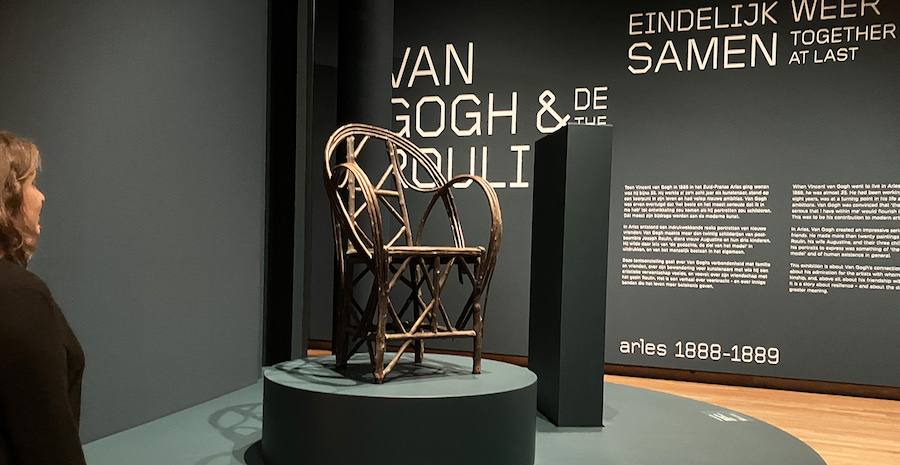
Chair from Van Gogh’s studio, Van Gogh Museum, Amsterdam (Vincent van Gogh Foundation). Photo © M. Guzzoni/Artlyst 2025.
It is exciting to think that on this rustic armchair, a man who had never posed in his life sat for multiple sessions, certainly chatting with the artist. The first took place on July 31, the day Roulin became a father for the third time. After Armand (17) and Camille (11), his wife, Augustine, had given birth to a daughter, Marcelle, and Vincent couldn’t wait to paint her portrait too.
The presence of this exceptional but straightforward element from Vincent’s studio makes the postman Roulin a real person.
An Entire Family, The Eternal Portrait
‘I’ve done the portraits of an entire family’, Vincent enthusiastically told his brother in early December, ‘the man, his wife, the baby, the young boy and the 16-year-old son, all characters are very French, although they have a Russian look. No. 15 canvas. You can sense how in my element that makes me feel…’
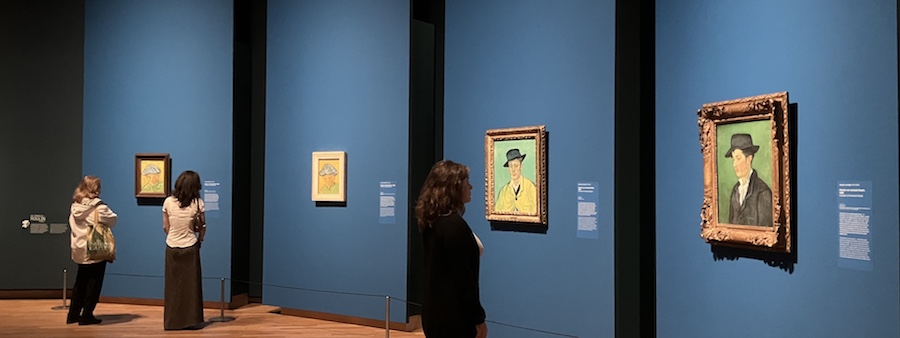
Van Gogh Museum, Amsterdam, installation view. Photo © M. Guzzoni/Artlyst 2025.
Vincent had left Paris earlier that year at the end of February, feeling he had no more to gain by staying. Together with his painter friends, Émile Bernard, Paul Signac and Georges Seurat, he had scoured the banks of the Seine for months, in search of new inspiration, with the precise intention of challenging the legacy of Impressionism, and with very different outcomes. Vincent had experimented with pointillist elements and neo-impressionist brushstrokes, exploring a range of styles. In the absence of models, he had scanned his face in the mirror and painted 27 self-portraits in two years, creating animated backgrounds made with dabs of pure pigments, or rhythmic strokes in complementary pairs of colours. In Provence, he turned the page and started all over again, finding more sunshine there, more colour. Now that he finally had people to sit for him, he was in his ‘element’. What did Van Gogh want from these new portraits? He tried to paint ‘the soul’ of the model. It is here that his differences with Gauguin (who had arrived at the Yellow House a month earlier) became acute.
Gauguin pursued the realm of dreams and imagination. Van Gogh, instead, sought reality; he adored ‘the true, the possible’. ‘Thinking and not dreaming’ is the duty of the artist, he would later write to Bernard. The Dutch masters taught as much, and they returned to his mind in Arles. To Vincent, Rembrandt was a ‘magician’, in his portraits of ordinary people, he knew how to ‘make poetry’. ‘To go to Rembrandt indirectly is perhaps the most direct route…’, he wisely suggested. Not to mention Frans Hals: ‘he painted portraits; nothing nothing nothing but that’, he wrote to his friend at the end of July, reiterating the importance of painting by the Dutch masters. We too can see in the exhibition how the portraits of Frans Hals and Rembrandt were a great inspiration for him. Hals’ Fisher Boy (ca 1630) is surprisingly modern in its immediacy and naturalness.
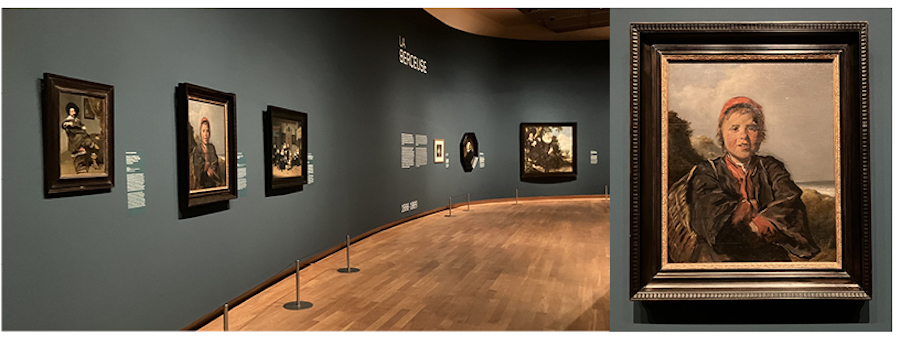
Van Gogh Museum, Amsterdam, installation view; Frans Hals, “Fisher Boy,” about 1630, Royal Museum of Fine Arts, Antwerp, Flemish Community. Photo © M. Guzzoni/Artlyst 2025.
Within a few weeks, between November and December, Vincent painted portraits of the whole family: Armand, Camille, and Marcelle. He began working on the maternal figure of Augustine, the celebrated ‘Berceuse’ (‘The Lullaby’), with a background of flowers, a motif he would repeat the following year in four subtly different versions (three of which are on display). The looks of all these people are impressive, each time new, now sweet, now pensive, now more serene, but always profound, even that of Camille, an eleven-year-old boy.
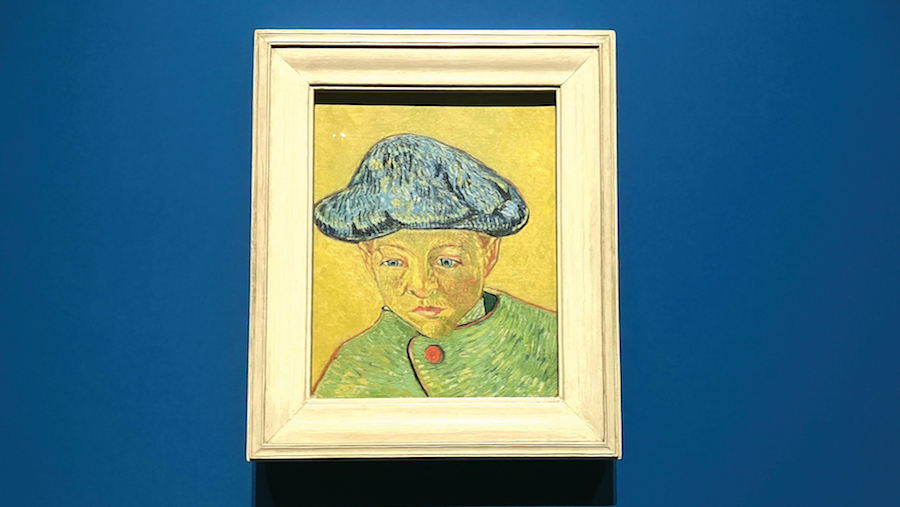
Vincent van Gogh, Camille Roulin, 1888, Philadelphia Museum of Art. Photo © M. Guzzoni/Artlyst 2025.
‘I always have hopes that a great revolution still awaits us in portraiture’, Vincent confessed to his sister Willemien in October. His revolution passes right through the Roulin family. In this group of paintings, his research emerges strongly, primarily with the use of colour. ‘Colour expresses something in itself, he had declared years earlier. The attention that Vincent dedicated in Paris to the figure-background relationship in portraits of himself reaches its highest point in Arles, approaching absolute purity. We see it in the December canvas: Roulin appears on a golden background, reminiscent of his buttons, a Russian icon. His gaze is gentle, his head slightly tilted. Two complementary colours, yellow and blue, are the masters and give a certain sacredness, or spiritual quality, to this extraordinary portrait.
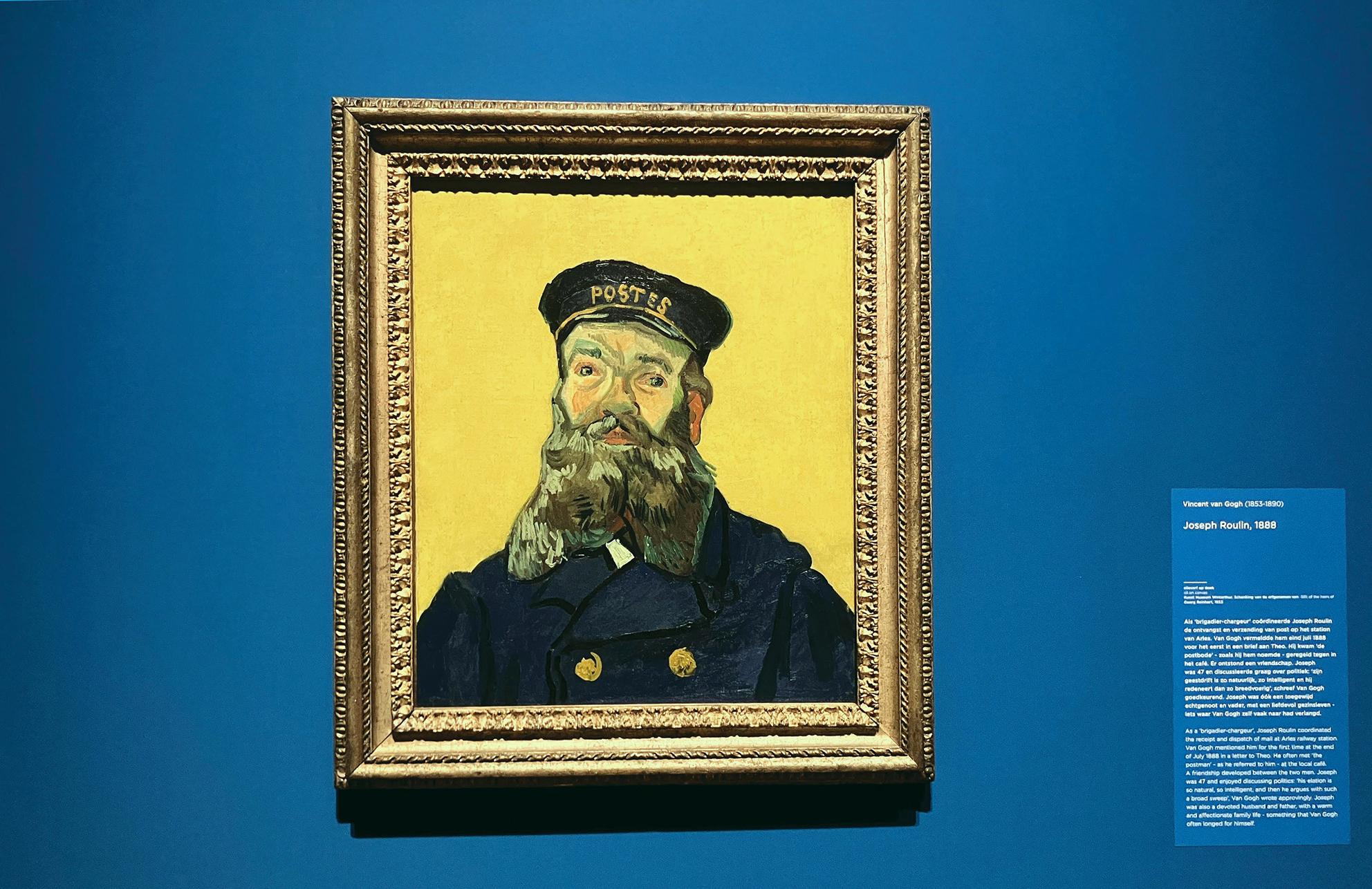
Vincent van Gogh, Joseph Roulin, 1888, Kunst Museum Winterthur. Photo © M. Guzzoni/Artlyst 2025.
Roulin would be the friend who remained close to him in misfortune. On December 24, Vincent was hospitalised for two weeks, after having cut off his ear the night before, following an argument with Gauguin. Theo had arrived on the night train but would return to Paris that same evening, and Gauguin also went, unconcerned for his friend. It was Roulin who would visit him every day, taking care of the Yellow House, and keeping in touch with Theo: his moving letters on display testify to this. To everyone’s great regret, at the end of January 1889, Roulin was transferred to Marseilles. The two met again a few times in Arles, and Roulin continued to comfort his friend with his wisdom: ‘do not be discouraged, work in those beautiful fields, take advantage of the models that nature provides you, with work health will return…’
‘What I’m most passionate about, much, much more than all the rest in my profession, is the portrait, the modern portrait. I seek it by way of colour, and am certainly not alone in pursuing it in this way. I would like, you see, I’m far from saying that I can do all this, but anyway I’m aiming at it, I would like to do portraits which would look like apparitions to people a century later, he wrote to his sister in 1890, two months before taking his own life.
But his goal had already been achieved, his ‘great revolution’ was accomplished, and this demonstrates it perfectly.
Top Photo: The first portrait of Joseph Roulin, Vincent van Gogh, Postman Joseph Roulin, 1888, Museum of Fine Arts, Boston. Photo © M. Guzzoni/Artlyst 2025.
Van Gogh and the Roulins. Together Again at Last Van Gogh Museum, Amsterdam 3 October 2025 – 25 January 2026
• Further reading:
The exhibition catalogue, Van Gogh. The Roulin Family Portraits includes contributions from the curators alongside texts by Chris Atkins, Rachel Childers, Muriel Geldof, Bregje Gerritse, Erin Mysak, Richard Newman, Kathrin Pilz and Lydia Vagts; on the stories behind Van Gogh’s models in Arles, see Le Café Van Gogh by Bernadette Murphy (2024).

